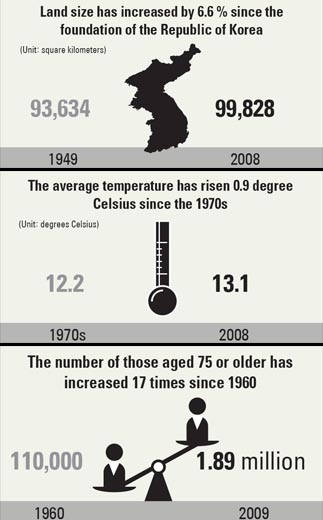Statistics paint Korean picture

Those are part of a new report combining 108 kinds of statistics released yesterday by Statistics Korea to show how much this country has changed over the past several decades.
The report showed that the number of people ages 75 and over was 1.89 million last year, accounting for 3.9 percent of the population. In 1960, the number was only 110,000, or 0.4 percent of the population.
The increase can be partly explained by another statistic in the report that says that life expectancy had risen over the past 40 years through 2007, by 25 years to 76.13 years for Korean men and by 29 years to 82.73 years for Korean women.
Because of the rapid pace of industrialization and global warming, the country’s average temperature rose from 12.2 degrees Celsius in the 1970s to 13.1 degrees Celsius last year, the report showed. That, the statistics agency said, is a significant increase compared with the 0.5 to 0.6 degree Celsius increase recorded around the world over the past 100 years.
The most common type of small business in Korea is the restaurant, which is reflected in statistics on the number of restaurants in the country. The number has risen sharply in recent years and stood at 585,025 last year, the report said.
However, that has decreased the number of people patronizing the restaurants. In 1960, there were 1,180 customers per restaurant, but that fell to 83 people per restaurant last year, one-fourteenth the number in 1960.
Restaurant prices have also risen significantly, as was shown by the price of jjajangmyeon, which rose from 35 won (3 cents) in 1965 to 3,773 won last year.
The number of “entertainment bars” - where alcohol is served and entertainment shows, blind dating services or illegal sex services are available - jumped 96 times from 472 in 1960 to 45,826 last year.
Meanwhile, the level of oil imports, a major factor in a country with few natural resources such as Korea, increased 4.7 times between 1980 and 2008, from 182.9 million barrels to 864.9 million barrels. The country’s dependence on the Middle East for oil grew from 76.8 percent in 2000 to 86.3 percent last year.
The report also showed that the number of kindergartens in 1965 was 423, which provided education for around 20,000 out of the 1.96 million children ages 4 to 5 in the country at the time.
But over the next 43 years the kindergarten admission rate rose from approximately 1 percent to 55.7 percent last year.
The number of hagwon, or private education institutes, rose 49 times between 1970 and last year, from 1,421 to 70,213. Last year, 47 percent of hagwon were cram schools for higher school enrollment.
By Moon Gwang-lip [joe@joongang.co.kr]










with the Korea JoongAng Daily
To write comments, please log in to one of the accounts.
Standards Board Policy (0/250자)